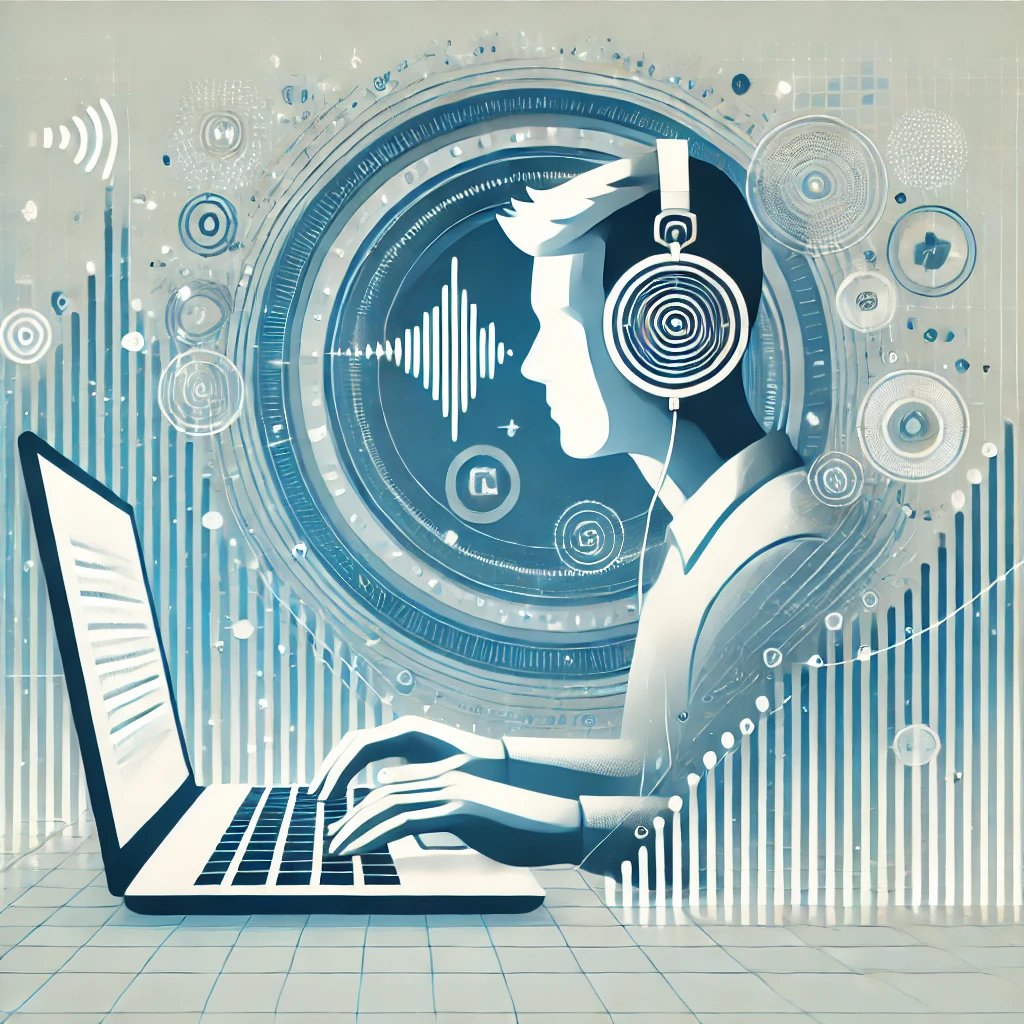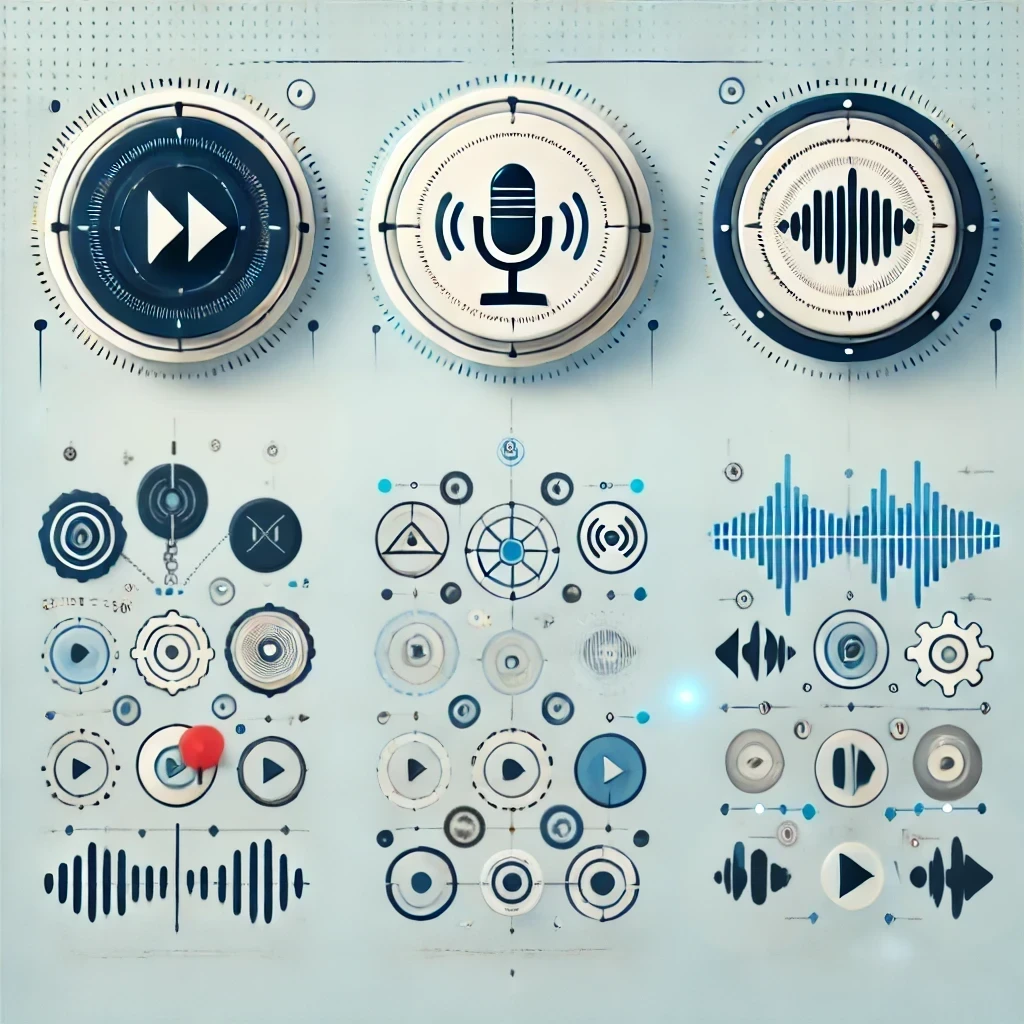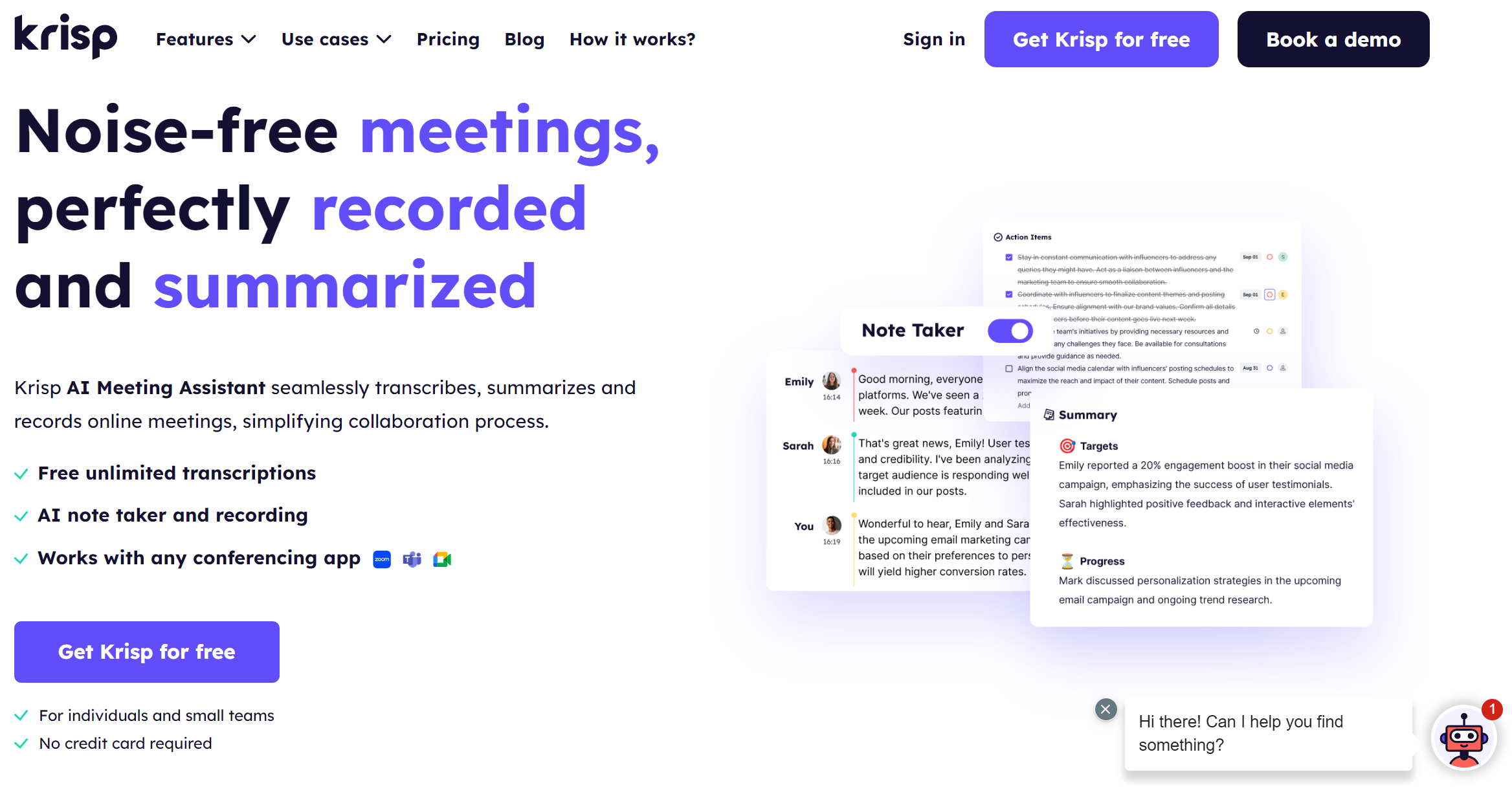Are you searching for verbatim transcription services or a company? A verbatim transcription is a transcription process that captures every spoken word, filler, hesitation, and non-verbal sound as they appear in the audio.
Look no further. From clean verbatim transcription meaning, examples, benefits, characteristics, use cases, types to test and rules, you can find in this guide.
Importantly, you’ll learn how the Krisp AI Meeting Assistant elevates verbatim transcription with super fast and accurate automated AI Note Taking.
What Is Verbatim Transcription?

A verbatim transcription captures spoken content exactly as you hear it. It includes every word, hesitation, repetition, and non-verbal sounds like sighs or laughter. Merriam-Webster defines “verbatim” as “in the exact words, word for word.”
Thus, this type of audio transcription provides an unaltered representation of the conversation. Therefore, it helps the reader understand emotions, tone, and communication dynamics.
This type of transcription is precious in industries like legal and organizational meetings or media production. Did you know the transcription services market is on the rise? For example, it’s anticipated to make up $41.89 billion in the US by 2030.
So, when is verbatim transcription necessary, and why? It’s required when you need to preserve the complete spoken content or exact details of spoken communication. That’s why this type of transcription is used in legal cases for accuracy and closed captions.
Verbatim Transcription Example: A speaker says, “Um, I think, you know, we should, uh, proceed with the proposal.” The transcript will include all the filler words and hesitations, preserving the authenticity of the speaker’s words.
What Is Non-Verbatim Transcription?
Non-verbatim transcription is transcribing audio into text while focusing on clarity and readability. It doesn’t capture every spoken word or sound.
Specifically, this type of transcription omits filler words like “um,” “uh,” repetitions, and non-essential speech elements, such as stutters or false starts.
The goal is to produce a polished, concise version of the content that retains the core meaning but eliminates superfluous elements.
Non-verbatim transcript creates readable documents for business meetings, interviews, or presentations, delivering clear and precise content.
Non-Verbatim Transcription Example: Let’s take this original audio, “Um, I think, uh, we should, like, move forward with the, um, project. You know, it’s really, really important, and, uh, we should start as soon as possible.”
The non-verbatim transcript will be, “I think we should move forward with the project. It’s essential, and we should start as soon as possible.”
In this non-verbatim transcript, filler words like “um” and “you know” and repeated phrases have been removed. This is how you get a more polished and readable version while retaining the original message.
Characteristics of Verbatim Transcriptions

Verbatim transcriptions are known for their detail and precision. Here are some defining characteristics:
- Comprehensive Inclusion: They encompass every spoken element, including pauses, fillers, and non-verbal cues, providing a complete account of conversations. This approach is beneficial in legal contexts where every word may hold significance.
- Raw Authenticity: These transcriptions capture the natural, unedited flow of speech, including stutters, interruptions, and emotional expressions. As a result, they become valuable for understanding true communication intent.
- Non-Verbal Cues: Beyond spoken words, verbatim transcriptions capture elements like tone, laughter, or pauses. For example, a long pause during a deposition may indicate hesitation or contemplation.
- Detailed Context: They preserve the full context of a conversation, including background noises that may influence interpretation. For instance, these transcriptions can include the sound of applause or sighs of agreement during a meeting.
- Emotional Nuances: The way something is said, including the tone or inflection, can be just as important as the words themselves. These transcriptions maintain these nuances, helping to convey emotions like frustration or enthusiasm.
Benefits of Verbatim Transcriptions
Verbatim transcriptions go beyond simply recording words. They offer detailed insights that can benefit a wide range of domains. Here are some key benefits:
- Preserving Complete Context: By capturing every word and non-verbal element, these transcriptions provide a deeper understanding of conversations. Thus, they’re ideal for academic research or legal proceedings where every detail matters.
- Unfiltered Authenticity: These transcripts are an accurate reflection of natural speech. That’s why they’re valuable for fields like psychological research and language studies, where understanding human communication patterns is essential.
- Accessibility and Inclusivity: Verbatim transcripts are vital for individuals with hearing impairments. Because they help access the complete content of conversations or events without missing any subtlety.
- Cultural Preservation: In recording oral histories, verbatim transcriptions help document cultural stories and traditions. Thus, they ensure that the way these stories are told, including complete with pauses, inflections, and emotions, remains preserved.
- Promoting Accountability: These transcriptions are a reliable record in settings like board meetings or interviews, holding individuals accountable for their exact words. That’s why they’re handy in legal or business contexts where accuracy is paramount.
What Are the Different Types of Verbatim Transcription?
While verbatim transcription generally means transcribing audio word-for-word, it can be adapted for various needs. Picking the right type depends on the situation, the audience, and the level of detail needed.
- Clean Verbatim Transcription
Also known as intelligent verbatim transcription, this type omits filler words like “uh,” “um,” and repetitive phrases that don’t change the meaning. A clean verbatim transcription example includes one that creates readable transcripts while still capturing the essence of the conversation.
Example: “I just wanted to discuss the new project proposal. It’s essential, I think.”
Here, fillers like “um,” “uh,” and repetitions are omitted. This transcript creates a smoother reading experience without altering the meaning of the original speech. This type is typical of business meetings or interviews.
- Full Verbatim
This type captures every sound, including filler words, stutters, and background noises. For example, in a courtroom, full verbatim captures every spoken detail, providing a raw, complete audio representation.
Example: “Um, well, I, I just wanted to, you know, [sighs], uh, discuss the new project proposal, right? It’s, uh, essential, I think.”
This type includes all the hesitations and fillers like “um,” “uh,” and repetitive phrases. Thus, it’s ideal for legal or research contexts where authenticity is critical.
- Edited Verbatim
Here, transcribers lightly edit the text to enhance readability without changing the meaning. For instance, they might clarify sentences while maintaining the speaker’s intent. That’s why this type is suitable for media transcripts or interviews.
Example: “I wanted to discuss the new project proposal because I think it’s important.”
For better understanding, the transcriber may rephrase or structure sentences differently in this version. Thus, edited verbatim is suitable for media production or public documentation where readability is more vital than exact replication.
Use Cases of Verbatim Transcription
Verbatim transcriptions have a broad range of applications across different fields. Here are some of the most common use cases:
- Organizational Meetings
Verbatim transcripts are essential for board meetings or shareholder discussions. Because they provide a precise record of decisions and discussions for future reference.
- Legal Proceedings
In courtrooms, legal verbatim transcription ensures that every word is accurately captured. Because it helps maintain transparency and support judicial decisions.
- Academic Research
Researchers rely on verbatim transcripts for qualitative analysis. These include studying communication patterns, analyzing interview data, and uncovering deeper insights.
- Media Production
These transcriptions are used to create accurate closed captions and subtitles. Because they ensure that spoken content aligns with visual media, improving accessibility for audiences.
- Historical Documentation
These transcriptions help preserve critical historical conversations, interviews, or speeches. How? They ensure future generations have an accurate record of these events.
How Long Does Verbatim Transcription Take?
The time required to complete a verbatim transcription depends on several factors. These can include the audio quality, length of the recording, complexity of the content, and experience of the transcriber. Here are some general estimates:
- Manual Transcription
A human transcriber typically completes a transcription in about four to six hours per audio hour.
However, the length of human transcriptions can increase if the audio includes multiple speakers, background noise, or technical jargon. Because these require more time to ensure accuracy.
- Automated Transcription Tools
Using AI-powered tools like Krisp’s AI Meeting Assistant can significantly reduce the time spent on transcriptions. How? Krisp’s Automatic Transcription Software delivers transcripts super fast, in real time. Moreover, Krisp’s AI Meeting Assistant Summarizes these Meeting Notes.
However, you may need a little more time to review and edit the transcript provided by an AI transcription tool for added accuracy. This is especially true of complex content.
- Factors That Affect Speed
- Audio Quality: Clear audio results in faster transcription since you need fewer replays to understand the dialogue.
- Number of Speakers: More speakers or overlapping dialogue can slow the process.
- Complexity of Language: Recordings with technical terms or specific jargon may require research, extending transcription time.
What Is a Verbatim Test?
A verbatim test assesses the accuracy of a transcription by comparing it directly with the original audio recording.
It ensures that every spoken word, filler word, stutter, pause, and non-verbal sound like laughter or sighs is accurately transcribed into written form.
This type of test is common in industries where precision is critical, such as legal or medical transcription. Why? Because even the smallest detail has significant implications.
For instance, medical professionals take SOAP (Subjective, Objective, Assessment, and Plan) notes using automated transcription services. Interestingly, the global medical transcription software market was valued at $2.24 billion in 2023.
So, a verbatim test ensures that the transcription matches the spoken content word-for-word, reflecting the authenticity and nuances of the original recording.
For example, let’s take an audio recording containing a specific sentence,
“Um, well, I, I just thought that, you know, maybe we should, uh, reschedule the meeting, right?”
The expected version will be, “Um, well, I, I just thought that you know, maybe we should, uh, reschedule the meeting, right?”
Verbatim Transcripts Rules
Specific rules ensure that every element of spoken content is captured accurately. Here are the most common verbatim transcription rules:
- Include Every Word and Sound
- Transcribe all words spoken, including filler words like “um,” “uh,” “you know,” and “like.” These contribute to the authenticity of the conversation.
- Include non-verbal sounds such as laughter, coughs, sighs, and pauses. For instance, you might write “[laughter]” or “[pause]” to indicate these moments.
- Capture False Starts and Stutters
- If a speaker starts a sentence but changes their mind or rephrases, include the false start. For instance, “I, I thought we could start with—actually, let’s begin with the other topic.”
- Identify Speakers
- Clearly indicate who is speaking, using labels like “Interviewer:” and “Respondent:” Or consider generic labels like “Speaker 1:” and “Speaker 2:” if the speakers aren’t identified by name.
- Don’t Edit for Grammar
- Maintain the natural flow of the speaker’s language, including grammatical errors, incomplete sentences, and colloquial expressions. This is how you can preserve the original tone and style of speech.
- Indicate Background Noise
- If significant background noise affects the recording, note it in the verbatim transcription. For example, use “[background noise]” or “[door slams]” when such events occur in the audio.
- Avoid Paraphrasing or Summarizing
- Don’t alter or rephrase anything. The goal is to accurately represent the spoken content without changing the original meaning.
Use Krisp for Automated Verbatim Transcription
Manual or human transcriptions take more time due to the need for precision. The good news is that the Krisp AI Meeting Assistant speeds up the process, providing exceptional 96% accuracy.
Krisp’s AI Meeting Assistant offers real-time verbatim transcription for added productivity and efficiency. Krisp’s AI Meeting Transcriptions are in multiple languages.
Moreover, the Krisp AI Meeting Assistant provides:
- Unmatched Noise Cancellation, eliminating background voices and echoes to help you focus on the meeting without distractions.
- Automatic Meeting Recording allows you to save your online discussions to revisit and review later, boosting accessibility and collaboration.
- Bot-free Screen Recording lets you easily capture, pause, and resume recordings without missing a moment. You can Record the Screen right from the Krisp app or Widget.
- Error-free Meeting Notes and Summaries so you can Record Meetings, Transcribe, and Summarize them accurately. Then, you can save the summarized vital points and action items for future reference.
How to Get Started with Krisp for Verbatim Transcription
Here is how to use the Krisp for exceptionally fast and accurate transcriptions to save time and effort:
- Register with Krisp: Sign up to access its AI-powered free transcription software.
- Download and Install the App: Available for Windows and Mac, install the Krisp’s Meeting Assistant app on your device.
- Set Krisp as Speaker and Microphone: Configure your meeting app to use the Krisp AI Meeting Assistant for noise-free communication.
- Start Your Meeting: Start online meetings, and Krisp’s AI Meeting Assistant will automatically transcribe the audio.
- Access Your Transcripts: Transcripts are available for review and minor edits on your dashboard.
TIME’s top pick for note-taking apps without an in-meeting bot, Krisp’s AI Meeting Assistant, captures every word thanks to its stellar speaker recognition technology.
Users note that the Krisp AI Meeting Assistant’s Noise Suppression algorithm seems ten times more powerful than its competitors.
- Krisp’s flagship Noise Cancellation technology has been deployed on 200M+ devices and is currently processing 80B+ minutes of conversations daily.
- Krisp’s AI Meeting Assistant runs on WinOS u MacOS and works well with videoconferencing tools like Zoom, Goole Meet, and Microsoft Teams.
- The Krisp AI Meeting Assistant doesn’t have a lot of bells and whistles and doesn’t use a bot to join meetings, which is aggressive and annoying.
- Krisp’s AI Meeting Assistant offers excellent usability, premium features, and competitive pricing.
- The Krisp AI Meeting Assistant helps millions of individuals and businesses raise productivity through the power of voice.
Conclusion
A verbatim transcription provides a precise recording or live event transcription. Adhering to strict rules that ensure authenticity, this transcription offers detailed content records.
Thus, verbatim transcripts are ideal for settings where accuracy is vital, such as legal proceedings, research, and media production.
Thankfully, the Krisp AI Meeting Assistant simplifies the transcription process, offering reliable and super fast results. As a result, you can preserve authentic dialogues and capture detailed discussions, ensuring authenticity and accountability.
Frequently Asked Questions
Non-verbatim transcription omits redundancies and focuses on readability.
Verbatim transcripts provide a rich data source for qualitative studies and in-depth analysis across various disciplines.
For instance, in a legal deposition, a transcript might read: “Um, I think, uh, we should proceed with, um, the plan, right?” This form maintains every hesitation and filler word to reflect authenticity.
For example, an interview transcript might read: “I, I—well, you know, [sighs] it’s like, really hard, um, to understand what’s, uh, happening.”
This preserves the exact speech pattern, interruptions, and expressions without omitting elements.
Non-verbatim transcription, also called “clean,” omits unnecessary elements like filler words and false starts, creating a more polished and readable version while retaining the core meaning.
It focuses on delivering a clear, readable version of the spoken content while retaining the original meaning, making it suitable for professional documentation.





